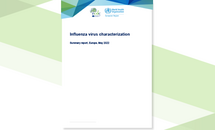Influenza virus characterisation - Summary Europe, May 2021
This is the seventh report for the 2020−2021 influenza season. As of week 20/2021, only 909 influenza detections across the WHO European Region had been reported to TESSy; 52% type A viruses, with A(H3N2) and A(H1N1)pdm09 being approximately equally represented, and 48% type B viruses, with only 16 having been ascribed to a lineage, 13 B/Victoria and three B/Yamagata. This represents a 99.4% drop in detections compared to the same period in 2020, probably due to the COVID-19 pandemic and measures introduced to combat it.
Executive Summary
Since the April 2021 characterisation report, only one shipment from an EU/EEA country (Norway) containing three clinical specimens has been received at the London WHO Collaborating Centre, the Francis Crick Worldwide Influenza Centre (WIC): consequently, little virus characterisation data has been generated. This report therefore focuses on genetic characterisation of the HA genes of seasonal influenza viruses deposited and/or released in GISAID during May 2021, with collection date periods adjusted for each virus subtype/lineage to allow production of readable phylogenies with sequences from viruses with the most recent collection dates included. The data continue to show extremely low levels of influenza detections. Few or no detections of A(H1N1)pdm09 and B/Yamagata-lineage viruses have been reported globally, while low numbers of A(H3N2) and B/Victoria-lineage viruses have been detected.
Just four A(H1N1)pdm09 HA sequences from viruses detected in the 2020−2021 season were made available in GISAID during May, three from infections with subgroup 6B.1A5A+187V/A viruses, represented by A/Guangdong-Maonan/SWL1536/2019 (the vaccine virus for the northern hemisphere 2020−2021 season), and one from a zoonotic H1N1v case (swine clade 1A.3.3.3). Two viruses from Norway with recent collection dates were recognised well in HI assays by post-infection ferret antiserum raised against the 2020−2021 vaccine virus, but poorly by antiserum raised against the 2021−2022 vaccine virus, A/Victoria/2570/2019.
Of the 26 HA sequences from recently collected A(H3N2) viruses, one each fell into the subgroups 3C.2a1b+T135K-A and 3C.2a1b+T135K-B, and 24 fell into the subgroup 3C.2a1b+T131K-A. The 3C.2a1b+T131K-A subgroup viruses were split into two antigenically distinguishable clusters, originally defined by viruses from Cambodia (n=10: with HA1 amino acid substitutions of G186S, F193S, Y195F and S198P, many also having K171N) and Bangladesh (n=14: with HA1 amino acid substitutions of Y159N, T160I (loss of a glycosylation site), L164Q, G186D, D190N, F193S and Y195F); with Bangladesh-like viruses showing the greatest geographical spread. The single virus from Norway characterised by HI in May showed a profile of reactivity, with a panel of post-infection ferret antisera, characteristic of that seen with a Bangladesh-like virus. An A/Cambodia/e0826360/2020-like virus (subgroup 3C.2a1b+T131K-A) has been recommended for use in the 2021−2022 northern hemisphere influenza season.
All 10 newly available B/Victoria-lineage HA sequences from viruses with collection dates during the 2020−2021 season fell within the N150K group of subclade 1A(3)B, with HA1 amino acid substitutions of N150K, G184E, N197D (loss of a glycosylation site) and R279K. When the N150K group was split into two subgroups, one of them, defined by HA1 substitutions A127T, P144L, E164K and K203R (often with additional substitutions), showed significant geographical spread, while a subgroup defined by HA1 substitutions V117I and V220M has been identified in the Russian Federation. Antigenically, viruses in subgroups of the N150K group differ and show some loss of reactivity with post-infection ferret antisera raised against the B /Washington/02/2019 vaccine virus, recommended for inclusion in influenza vaccines for the 2020−2021 and 2021−2022 northern hemisphere seasons and 2021 southern hemisphere season.
Seven B/Yamagata-lineage HA sequences from clinical specimens collected in the United States during the 2019−2020 season were deposited in and/or released to GISAID during May. Similar to previously released sequences from viruses with collection dates in 2020, they belong to genetic clade 3 and carry three HA1 amino acid substitutions (L172Q, D229N and M251V), compared to the B/Phuket/3073/2013-like viruses which have been recommended for use in quadrivalent influenza vaccines for the 2020-2021 and 2021-2022 northern hemisphere seasons and 2021 southern hemisphere season. The antigenic effects of these amino acid substitutions have been minimal, as assessed in earlier reports.
Download







